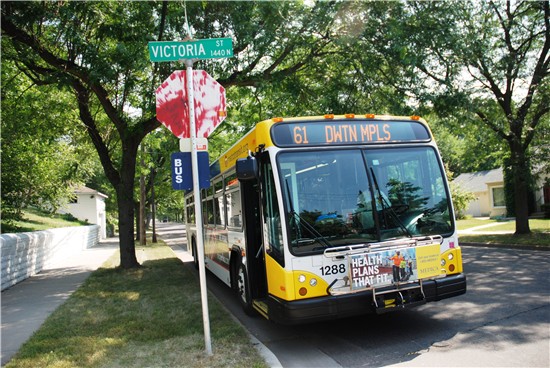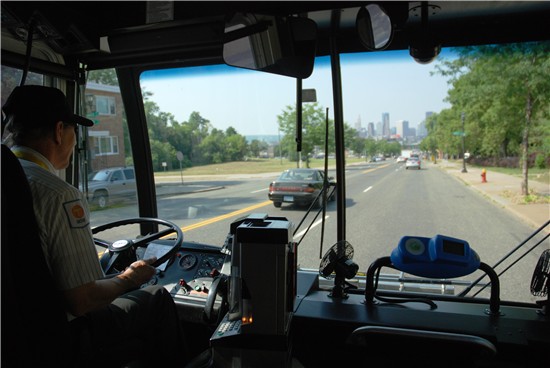 Bucolic farm views aren’t what customers expect to find while riding one of Metro Transit’s urban bus routes.
Bucolic farm views aren’t what customers expect to find while riding one of Metro Transit’s urban bus routes.
But that’s what they’ll find on Route 61 as it passes the University of Minnesota’s St. Paul campus. Acres of corn, tomatoes and other vegetables come into view as the bus rolls down Larpenteur Avenue and past the fields adjoining campus.
The agrarian environment is just one of the scenes customers encounter while riding Route 61, however. The crosstown bus also passes through quiet, tree-lined residential streets, past large industrial warehouses and over the Mississippi River as it makes its way between downtown Minneapolis and downtown St. Paul.
For two weeks every summer, it also passes near one of the state’s largest events: the Minnesota State Fair. The fairgrounds sit just south of Larpenteur Avenue, between Cleveland and Snelling Avenues and can be reached by Route 61 customers willing to walk a short distance to the entrance. (Regular service on Route 3 and Route 84 can also bring customers to the fair; see all available transit options here.)
Even without that extra attraction, though, Route 61 is seeing its fair share of customers. Nearly 780,000 customers boarded Route 61 buses last year, up around 3 percent from 2011.
Among them is Ritesh Katwal, a 25-year-old University of Minnesota student who uses the bus to travel between school and his home in St. Paul. Without a car, Katwal said the bus is so important to him that he plans his classes around the bus schedule.
“The 61 is the only bus I take and I take it all the time – to school, libraries, wherever I can go,” he said recently as he returned home from class.
 Chuck Weber moved to St. Paul just two months ago but has already made a habit of riding Route 61. Weber said he boards once or twice a day, usually to get to the YMCA in downtown St. Paul. Though he has a car, he says he prefers to ride the bus for environmental reasons and to avoid paying for parking.
Chuck Weber moved to St. Paul just two months ago but has already made a habit of riding Route 61. Weber said he boards once or twice a day, usually to get to the YMCA in downtown St. Paul. Though he has a car, he says he prefers to ride the bus for environmental reasons and to avoid paying for parking.
Now retired, Weber also benefits from a 75-cent senior fare, available to customers who are at least 65-years-old.
“I like the bus because it’s environmentally more sound but it’s also a lot cheaper,” Weber said.
Route 61 was created in 2001, when a series of service changes went into effect. A number of routes were either eliminated or consolidated, allowing Metro Transit to create a more direct crosstown route. One of Route 61's primary purposes is to link residents in east St. Paul to downtown Minneapolis. But the route also provides local service to businesses along Larpenteur Avenue and downtown St. Paul.
Responding to strong demand, weekday spans on Route 61 were expanded in early 2013. Plans are now in place to improve station areas in downtown St. Paul, including the transit center at Fifth and Minnesota streets, where passengers board Route 61 and several other routes.
Future service improvements could be made to East Seventh and Arcade streets, once home to a streetcar line that ran between St. Paul and White Bear Lake. The streets have been identified as candidates for Arterial Bus Rapid Transit, which would improve travel time along a nearly 9-mile stretch between the METRO Green Line in downtown St. Paul and the Maplewood Mall Transit Center.
A Metro Transit study suggests more than 13,000 weekday passengers could use ABRT by 2030.
As that planning continues, longtime customer Michael Chappell said he's happy with what's already in place. Now 51-years-old, Chappell has been riding the bus since he was a child and finds himself amazed with the consistency of service he's experienced.
"It's never too late, never too early -- always on time," he said.
 Route 61 At a Glance
Route 61 At a Glance
Type: Urban Local
Service: Route 61 runs between the Ramp A/7th Street Transit Center in downtown Minneapolis and the Smith Avenue Ramp near downtown St. Paul. Buses run along East Hennepin Avenue, Larpenteur Avenue, Arlington Avenue, Arcade Street and East Seventh Street. In St. Paul, Route 61 stops at Fifth and Minnesota streets, adjacent to the METRO Green Line's Central Station. Buses run between roughly 5 a.m. and 11:30 p.m., approximately every 20 minutes during rush hour, every half-hour midday and every hour in the evening. Downtown Zone fares apply in both Minneapolis and St. Paul.
Route length: Approximately 15 miles
Stops: 132 eastbound stops and 134 westbound stops
Vehicles: 40-foot standard buses
Ridership: Route 61 saw nearly 780,000 customer boardings in 2012, with an average of more than 2,531 daily passengers.
History: Route 61 launched in 2001 following a series of service changes that led other routes to be consolidated or eliminated. It was created primarily to provide a direct connection between east St. Paul and downtown Minneapolis and to provide service to businesses along Larpenteur Avenue. Parts of Route 61 -- East Seventh and Arcade streets -- were once home to a streetcar line between downtown St. Paul and White Bear Lake.
Future: East Seventh and Arcade streets are under consideration for Arterial Bus Rapid Transit, which would bring faster service to the corridor along with new technology, buses and improved station areas.